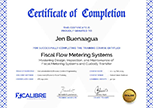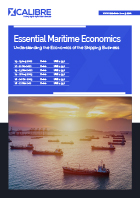| Date | Venue | Fee | |
|---|---|---|---|
| 10 Aug - 14 Aug 2026 | Dubai – UAE | $ 5,950 | Register Now |
| 12 Oct - 16 Oct 2026 | Dubai – UAE | $ 5,950 | Register Now |
| 14 Dec - 18 Dec 2026 | Dubai – UAE | $ 5,950 | Register Now |
About the Course
This Essential Maritime Economics training course aims to provide a comprehensive economic overview of the main pillars of the maritime business. Deliberate how the seaborne trade has evolved over the past centuries and analyse the macroeconomic factors influencing the shipping market cycles. They are looking at the key drivers of the demand and supply of the shipping industry and how these interactions determine freight rates. At this point, the delegate will be able to consider the practical market dynamics of the vital shipping markets – how freight is connected to new buildings, secondhand ships and demolition. Then, dissect the operations and economics of shipping companies and understand what determines their profitability and resilience during down markets.
Delve into how ships and shipping companies get financed using equity, debt, leasing & newbuilding finance. The geographic dimension of the maritime trade flows comes next, where it needs to analyse trade theory to explain commodity-trading patterns between countries. Explain the infrastructure and systems used for bulk handling and transportation of various commodities, discuss containerisation and liner shipping dynamics, and how specialised cargoes like chemicals and LNG are handled. Gain an understanding of the multiple aspects of the world’s merchant marine fleet, including the main categories of ships and shipbuilding and the ship scrapping industry. Therefore, by evaluating how the shipping business is changing due to the latest technological developments and regulations related to environmental considerations.
Core Objectives
The delegates will achieve the following objectives:
- Gain a solid understanding of the economic underpinning of the shipping business
- Develop an appreciation of key factors driving the demand & supply of the various shipping markets
- Formulate a profitable operations strategy for a shipping company
- Interpret economic data and build models to make reliable forecasts about the shipping market dynamics
- Evaluate and decide on the best financing options for purchasing a vessel
- Assess the best response to the environmental, regulatory & technological challenges being faced by the shipping industry
- Build shipping pricing models for trading in bulk commodities and containers
Training Approach
This training course speaks directly to the practical, day-to-day work of the delegates. That is why there is particular emphasis on real-life examples and case studies. The delegates will know how the theoretical principles relate to the current state of affairs, encouraging an interaction and experience sharing that adds value. Provides a unique perspective by drawing on the real-life experience of working onboard ships and finance & banking knowledge.
The Attendees
Apart from the people directly working within shipping companies, the course will benefit professionals in commodity trading, oil & gas, logistics, freight forwarding, classification societies, manning companies, government, banking & consulting.
This training course is suitable for a wide variety of professionals related to the shipping industry in any commercial capacity.
- Ship Operations Manager
- Fleet Manager
- Technical Superintendent
- Ship Surveyor
- Charterer
- Commodity Trader
- Commodity Trade Analysts / Consultants
- Shipping Banker
- Port Manager
- Shipbuilding Manager
- Transport Policy Consultant
- Freight Derivative Trader
- Asset Manager interested in Shipping Investments
Daily Discussion
DAY ONE: OVERVIEW
- A Historical Perspective
- Overview of the Shipping Industry
- Trade & the Sea Transport Demand
- Key components of the Sea Transport System
- Merchant Vessels
- Shipping Companies & Ports
- The Shipping Market Cycles
DAY TWO: ECONOMICS OF SHIPPING MARKETS
- A model for the Shipping Market
- Demand & Supply of Sea Transport
- Key Drivers of Demand & Supply
- How do freight rates get determined?
- The Freight Market
- The Freight Rate Derivatives Market
- The Sale & Purchase Market
- The Newbuilding Market
- The Demolition Market
DAY THREE: FINANCES OF THE SHIPPING COMPANY
- The Financial Performance: Revenue, Expenses, Cashflow
- Investment Strategy
- How to value ships?
- Ways to Finance Ships
- Risks & Defaults in Shipping Finance
- The ROI of Shipping Investments
- Pricing Shipping Risk
DAY FOUR: UNDERSTANDING SEABORNE TRADE
- The geographical aspect of shipping
- Key features of different continent’s trading networks
- Trade theory & why countries trade
- Commodity Trade Cycles
- Transporting Bulk Cargoes
- Transporting Specialised Cargoes
- Transporting General Cargoes
DAY FIVE: UNDERSTANDING THE SUPPLY SIDE ECONOMICS & REGULATIONS
- Types of ships in the World’s Merchant Fleet
- Ship Design Considerations
- Economics of Shipbuilding and Scrapping
- Shipbuilding Market Cycles
- Maritime Regulatory System
- Digital Technology in Shipping
- Environmental Considerations
Certificate Awarded
Upon successful completion of this training course, participants will be awarded a Certificate of Completion from XCalibre Training Centre, acknowledging their accomplishment. This certificate serves as a testament to their dedication to developing their skills and advancing their expertise in their respective fields.



